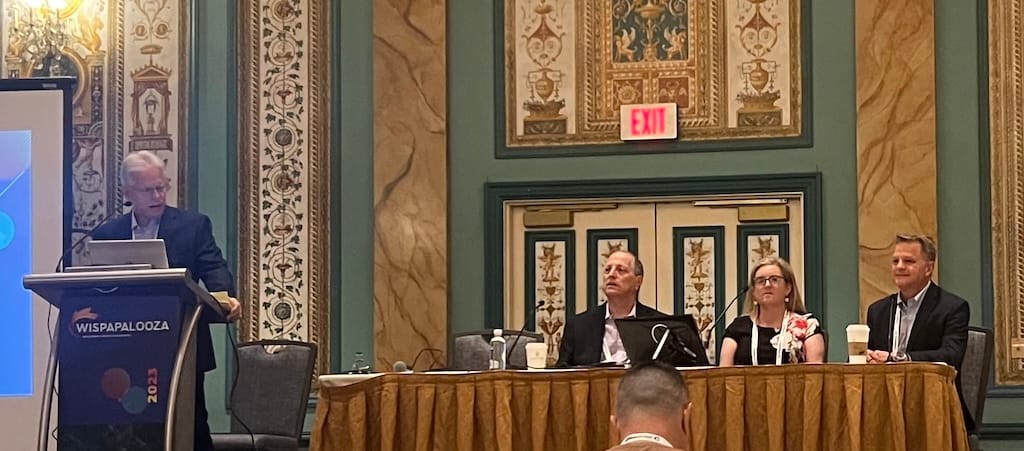Broadband Providers Should Prepare Now for BEAD Applications
The WISPAPALOOZA panel outlined key BEAD rules for small providers and WISPs to be familiar with.

LAS VEGAS, October 11, 2023 – Experts urged small broadband providers on Wednesday to start preparing now for BEAD grant applications.
The Biden administration’s $42.5 billion Broadband Equity, Access and Deployment program is still in its early stages. States have until December 27 to submit initial proposals for implementing the program to the National Telecommunications and Information Administration. Only Louisiana has started accepting challenges to broadband map data, the next step in the process.
Even so, providers considering applying for funds should familiarize themselves with BEAD requirements and their state’s proposals, said Lori Adams, Nokia’s vice president of broadband policy and funding strategy.
“Start that process now. Don’t wait until next year, because then it will be too late,” she said here at WISPAPALOOZA, the annual conference of small and fixed wireless broadband providers.
Adams and other panelists highlighted key requirements from the National Telecommunications and Information Administration that potential applicants should familiarize themselves with.
Letter of credit
The NTIA requires that providers awarded BEAD grants obtain a letter of credit from an eligible bank for at least 25 percent of their project costs.
Banks with a Weiss credit rating of B- or higher are considered eligible. There are some large banks that do not meet this requirement, noted Steve Coran, WISPA’s counsel and an attorney at Lerman Senter.
“The supply of banks is probably lower” than applicants realize, he said.
Letters of credit often require cash collateral, meaning BEAD subgrantees will have to set aside 25% of their project costs. The collateral must be held for the duration of the project, meaning that money can’t be accessed until builds are complete.
The broadband industry has expressed concern about the requirement. The NTIA said on September 22 it is working on updates to the letter of credit rules.
Build America, Buy America
The Build America, Buy America provision of the 2021 Infrastructure Act requires that all federally funded projects allocate 55 percent of their component cost to American suppliers and use equipment manufactured in America.
“That’s a very difficult proposition for some items because we have global supply chains,” Adams said.
The NTIA released in August a draft waiver that would, if adopted, exempt most broadband electronics from the American supplier requirement – including all technology necessary for fixed wireless providers. The four categories not covered by the waiver are used for fiber-optic deployments.
Adams noted applicants planning to deploy fiber cannot circumvent the BABA requirements by absorbing the cost of components themselves and not including them in grant applications.
“If you’re deploying it in the field as part of the program, it has to be BABA compliant,” she said.
Subgrantees will not have to replace existing equipment that would not have complied with the rule.
Matching funds
The NTIA also requires subgrantees to produce matching funds totalling at least 25 percent of BEAD project costs. That can come in the form of cash or in-kind donations, like easements and rights of way from municipalities or donated equipment and labor.<
States are also looking into using unallocated funds from other federal sources like the Capital Projects Fund and the American Rescue Plan Act as sources of matching funds, said Gregory Guice, chief policy officer at lobbying firm Vernonburg Group.
Some of those funds will have different requirements for projects. The CPF has a higher minimum speed requirement than the BEAD program, for example.
Applicants might need to exceed the 25 percent minimum if they are bidding against many other providers, Adams noted.
“You might need as much as 40% to be competitive,” she said.
High cost per location threshold
BEAD rules require states to prioritize fiber infrastructure. But when fiber becomes too expensive, states can consider other technologies like fixed wireless to serve hard-to-reach areas for less money.
States can choose at what price per location they will start looking at non-fiber grant applications. Knowing that threshold for states providers are looking to apply in will be ket for WISPs, the panel said.
The NTIA’s rules currently leave unlicensed fixed wireless out of the definition of adequate broadband. Coran said it’s possible states could ask for waivers. In volume two of Louisiana’s initial proposal, the state said it will seek NTIA approval on allowing funds for fixed wireless service using unlicensed spectrum in some cases.










